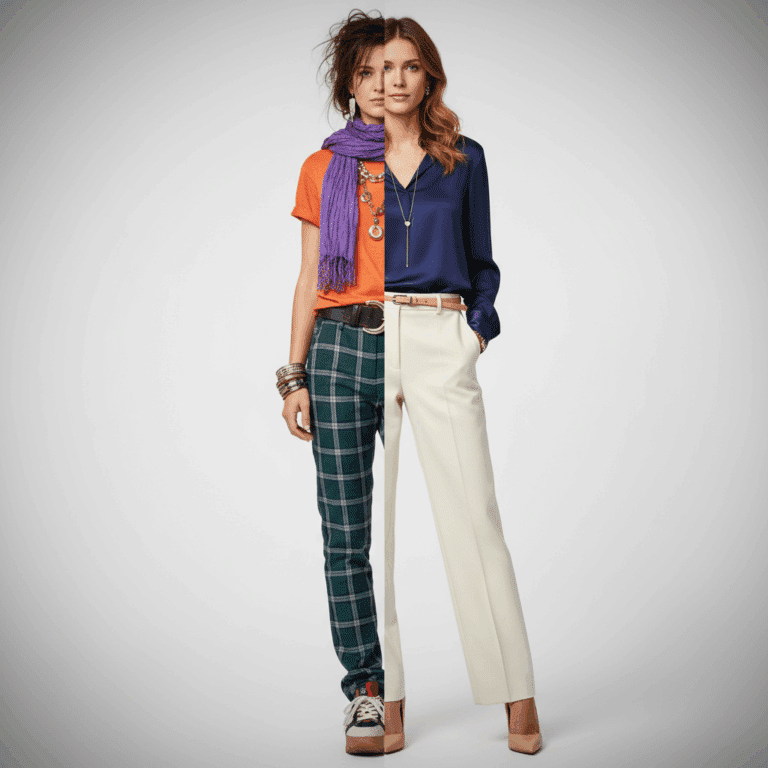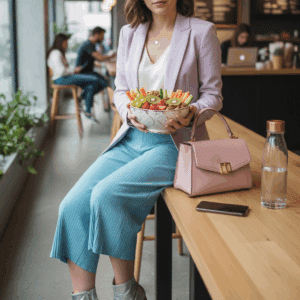Common Fit and Comfort Mistakes
One of the most frequent fashion errors is wearing clothes that do not fit properly. Ill-fitting garments can distort your silhouette and negatively impact your overall appearance.
Ensuring that your clothes fit well enhances confidence and comfort. Prioritize fittings and tailor items if necessary to achieve a flawless look.
Comfort should never be sacrificed for style. Wearing uncomfortable pieces affects your posture and how you carry yourself throughout the day.
Wearing Ill-Fitting Clothes
Clothes that are too tight can restrict movement and create unflattering bulges, while overly loose clothing may appear sloppy and unkempt. Both extremes detract from your style.
Try on garments before purchasing to evaluate fit and comfort. Professional tailoring can adjust pieces to complement your body shape perfectly, elevating your look.
Remember, the right fit accentuates your best features and boosts your self-esteem by eliminating discomfort and awkwardness in your outfit.
Sacrificing Comfort for Style
Choosing fashion over comfort often results in wearing items that feel restrictive or cause pain, which affects your confidence and natural movement.
Opt for clothing and shoes that combine style with comfort. When you feel good physically, it reflects in your appearance and demeanor.
Ultimately, comfort enhances your ability to enjoy any occasion without distraction, making it a crucial aspect of smart dressing.
Dress Code and Occasion Awareness
Understanding and adhering to dress codes is essential to avoid common fashion mistakes. Wearing the wrong attire for an event can make you feel out of place and uncomfortable.
Choosing appropriate footwear and matching your outfit to the event’s formality ensures your look is polished and respects the occasion’s standards.
Awareness of these factors not only boosts your confidence but also prevents awkward situations and creates a positive impression.
Ignoring Dress Codes
Disregarding dress codes can result in inappropriate outfit choices that clash with the event’s expectations. It’s important to verify the dress code in advance.
Being underdressed or overdressed can affect your comfort and social interactions. Selecting clothes that match the dress code shows respect and awareness.
When in doubt, aiming slightly more formal is safer than dressing too casually. This approach protects your reputation and helps you blend seamlessly.
Selecting Appropriate Footwear
Choosing footwear that matches the outfit and occasion is vital. Shoes that clash with your attire or the event can disrupt the harmony of your look.
Comfortable, clean, and well-maintained shoes enhance your appearance and ensure ease throughout the event’s duration.
Consider the setting—heels for formal events, stylish sneakers for casual gatherings—so your footwear complements your overall style and the environment.
Matching Outfit to Event Formality
Matching your outfit’s formality to the event is key to avoiding fashion faux pas. Each occasion has its own expectations for appropriate dress.
Casual attire suits relaxed events, while formal occasions demand polished and classic styles. Understanding these nuances is essential for confident dressing.
Tip for Success
Research event details or ask hosts if unsure about formality. When balanced correctly, your outfit reflects both style and respect for the occasion.
Color, Pattern, and Accessory Errors
Choosing the right colors and patterns is crucial to a cohesive outfit. Clashing hues or busy patterns can overwhelm your look and create visual confusion.
Accessories should enhance your style, not overpower it. Over-accessorising can distract from your outfit and appear cluttered rather than polished.
By mastering color coordination and thoughtful accessorising, you can elevate your fashion sense and ensure your outfit feels balanced and intentional.
Clashing Colors and Patterns
Combining colors that don’t complement each other can disrupt your overall look. Stick to a unified color palette to maintain harmony in your outfit.
Mixing multiple patterns without a cohesive plan often results in visual chaos. Choose one statement pattern and pair it with solid colors for a balanced effect.
Subtle contrasts can work well, but bold clashes tend to draw unwanted attention. When in doubt, keep things simple and elegant by selecting fewer colors or patterns.
Experiment gradually with patterns to build confidence. Mastering this skill helps you stand out stylishly without appearing mismatched or overwhelming.
Over-Accessorising
Wearing too many accessories can create a cluttered and distracting appearance that overshadows your clothing and personal style.
Select a few key pieces that complement your outfit rather than covering every part with jewelry or embellishments. Less is often more in accessorising.
Before leaving, revisit your accessories and remove anything that feels excessive. A refined look is achieved by thoughtful curation rather than abundance.
Maintaining Personal Style and Outfit Details
Maintaining your personal style is essential for authentic fashion expression. Following trends blindly can cause you to lose your unique voice in style.
Equally important is attention to cleanliness and garment presentation, which reflects your overall grooming and respect for yourself and others.
By combining these factors, you project confidence and individuality, key elements that elevate your fashion sense beyond superficial trends.
Neglecting Personal Style for Trends
Chasing every new trend may lead you to wear pieces that don’t suit your personality or lifestyle. This disconnect can make your outfit feel forced and uncomfortable.
Instead, focus on incorporating trends selectively within your personal style framework. This ensures you stay current while remaining true to who you are.
Personal style longevity comes from consistency and self-awareness, so prioritize garments and accessories that resonate with your tastes and values.
Doing so keeps your wardrobe cohesive and your appearance genuine, which naturally boosts confidence and fashion credibility.
Overlooking Cleanliness and Presentation
Wearing wrinkled, stained, or ill-maintained clothes creates a careless image, no matter how stylish the pieces may be. Cleanliness is non-negotiable for polished style.
Regular laundering, proper ironing, and removing visible tags or loose threads are simple steps that significantly improve your outfit’s presentation.
Footwear should also be clean and well-kept as dirty or scuffed shoes diminish even the most thoughtful outfit choices.
Why Details Matter
Small details convey respect for oneself and the occasion. They contribute to first impressions and can elevate or undermine your entire look.
Paying attention to these finishing touches signals maturity and fashion awareness, which sets you apart in any social or professional setting.






